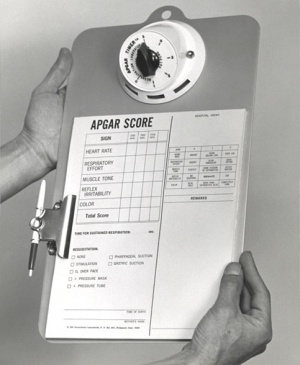Apgar test
| Embryology - 27 Apr 2024 |
|---|
| Google Translate - select your language from the list shown below (this will open a new external page) |
|
العربية | català | 中文 | 中國傳統的 | français | Deutsche | עִברִית | हिंदी | bahasa Indonesia | italiano | 日本語 | 한국어 | မြန်မာ | Pilipino | Polskie | português | ਪੰਜਾਬੀ ਦੇ | Română | русский | Español | Swahili | Svensk | ไทย | Türkçe | اردو | ייִדיש | Tiếng Việt These external translations are automated and may not be accurate. (More? About Translations) |
Introduction
The Apgar test is a historic neonatal test designed by Dr Virginia Apgar<[1] used in nearly all maternity clinics to assess the newborn infants well being assigned scores for each of 5 indicators: Heart Rate, Respiratory Effort, Reflex Irritability, Muscle Tone, Colour
Measured at one and five minutes after birth the Score values are totalled for all indicators: 7-10 is considered normal, 4-7 may require resuscitative measures, 3 and below require immediate resuscitation.
In recent years there has been some controversy of the relevance and accuracy of some of the criteria used in this test, though many feel it is still an invaluable initial assessment tool particularly where medical services are limited.
| Neonatal Diagnosis Links: neonatal diagnosis | Apgar test | Guthrie test | hearing test | Electrocardiogram (ECG/EKG) | X-ray | Tandem mass spectrometry | Classification of Diseases |
Some Recent Findings
|
Low Apgar and cerebral palsy
Proportions diagnosed with cerebral palsy according to Apgar score in children with birth weight of less than 1500 g, 1500-2499 g, and 2500 g or more.
The Medical Birth Registry of Norway was used to identify all babies born between 1986 and 1995. These data were linked to the Norwegian Registry of Cerebral Palsy in Children born 1986-95, which was established on the basis of discharge diagnoses at all paediatric departments in Norway.
- "Low Apgar score was strongly associated with cerebral palsy. This association was high in children with normal birth weight and modest in children with low birth weight. The strength of the association differed between subgroups of spastic cerebral palsy. Given that Apgar score is a measure of vitality shortly after birth, our findings suggest that the causes of cerebral palsy are closely linked to factors that reduce infant vitality."
Reference: Association of cerebral palsy with Apgar score in low and normal birthweight infants: population based cohort study. Lie KK, Grøholt EK, Eskild A. BMJ. 2010 Oct 6;341:c4990. doi: 10.1136/bmj.c4990.
Apgar Test Scores
| Indicator | Score 0 | Score 1 | Score 2 |
| Activity (muscle tone) |
Limp; no movement | Some flexion of arms and legs | Active motion |
| Pulse (heart rate) |
No heart rate | Fewer than 100 beats per minute | At least 100 beats per minute |
| Grimace (reflex response) |
No response to airways being suctioned | Grimace during suctioning | Grimace and pull away, cough, or sneeze during suctioning |
| Appearance (color) |
The baby's whole body is completely bluish-gray or pale | Good color in body with bluish hands or feet | Good color all over |
| Respiration (breathing) |
Not breathing | Weak cry; may sound like whimpering, slow or irregular breathing | Good, strong cry; normal rate and effort of breathing |
| Table data[1] Apgar test - Measured at one and five minutes after birth, the score values are totalled for all indicators: | |||
| Total Score: | 3 and below require immediate resuscitation | 4 to 7 may require resuscitative measures | 7 to 10 is considered normal |
|---|---|---|---|
Reassessment of Apgar Score
Two large 2001 neonatal studies have examined whether the Apgar score is still a relevant neonatal assessment tool.
- Low 5-minute Apgar score: a population-based register study of 1 million term births.[5] "Several obstetric risk factors are associated with low 5-minute Apgar score in term infants. Mortality and the risk of severe neurologic morbidity are increased in these infants."
- The continuing value of the Apgar score for the assessment of newborn infants.[6] "The Apgar scoring system remains as relevant for the prediction of neonatal survival today as it was almost 50 years ago."
References
- ↑ 1.0 1.1 APGAR V. (1953). A proposal for a new method of evaluation of the newborn infant. Curr Res Anesth Analg , 32, 260-7. PMID: 13083014
- ↑ AIHW 2016. National Core Maternity Indicators stage 3 and 4 results from 2010–2013. Cat. no. PER 84]. Canberra: AIHW.
- ↑ Lie KK, Grøholt EK & Eskild A. (2010). Association of cerebral palsy with Apgar score in low and normal birthweight infants: population based cohort study. BMJ , 341, c4990. PMID: 20929920
- ↑ Kidanto HL, Mogren I, Massawe SN, Lindmark G & Nystrom L. (2009). Criteria-based audit on management of eclampsia patients at a tertiary hospital in Dar es Salaam, Tanzania. BMC Pregnancy Childbirth , 9, 13. PMID: 19323846 DOI.
- ↑ Thorngren-Jerneck K & Herbst A. (2001). Low 5-minute Apgar score: a population-based register study of 1 million term births. Obstet Gynecol , 98, 65-70. PMID: 11430958
- ↑ Casey BM, McIntire DD & Leveno KJ. (2001). The continuing value of the Apgar score for the assessment of newborn infants. N. Engl. J. Med. , 344, 467-71. PMID: 11172187 DOI.
Reviews
Bharti B & Bharti S. (2005). A review of the Apgar score indicated that contextualization was required within the contemporary perinatal and neonatal care framework in different settings. J Clin Epidemiol , 58, 121-9. PMID: 15680744 DOI.
Leuthner SR & Das UG. (2004). Low Apgar scores and the definition of birth asphyxia. Pediatr. Clin. North Am. , 51, 737-45. PMID: 15157595 DOI.
Juretschke LJ. (2000). Apgar scoring: its use and meaning for today's newborn. Neonatal Netw , 19, 17-9. PMID: 11949546 DOI.
Articles
APGAR V. (1953). A proposal for a new method of evaluation of the newborn infant. Curr Res Anesth Analg , 32, 260-7. PMID: 13083014
Hellström-Westas L, Forsblad K, Sjörs G, Saugstad OD, Björklund LJ, Marsál K & Källén K. (2006). Earlier Apgar score increase in severely depressed term infants cared for in Swedish level III units with 40% oxygen versus 100% oxygen resuscitation strategies: a population-based register study. Pediatrics , 118, e1798-804. PMID: 17142501 DOI.
O'Donnell CP, Kamlin CO, Davis PG, Carlin JB & Morley CJ. (2006). Interobserver variability of the 5-minute Apgar score. J. Pediatr. , 149, 486-9. PMID: 17011319 DOI.
O'Donnell CP, Kamlin CO, Davis PG, Carlin JB & Morley CJ. (2006). Interobserver variability of the 5-minute Apgar score. J. Pediatr. , 149, 486-9. PMID: 17011319 DOI.
Keenan W. (2006). The Apgar challenge. J. Pediatr. , 149, 440. PMID: 17011310 DOI.
Thorngren-Jerneck K & Herbst A. (2001). Low 5-minute Apgar score: a population-based register study of 1 million term births. Obstet Gynecol , 98, 65-70. PMID: 11430958
Casey BM, McIntire DD & Leveno KJ. (2001). The continuing value of the Apgar score for the assessment of newborn infants. N. Engl. J. Med. , 344, 467-71. PMID: 11172187 DOI.
Search Pubmed
Search PubMed May 2010 "Apgar test" All (2327) Review (70) Free Full Text (294)
Search PubMed: Apgar | Apgar test | Virginia Apgar
Glossary Links
- Glossary: A | B | C | D | E | F | G | H | I | J | K | L | M | N | O | P | Q | R | S | T | U | V | W | X | Y | Z | Numbers | Symbols | Term Link
Cite this page: Hill, M.A. (2024, April 27) Embryology Apgar test. Retrieved from https://embryology.med.unsw.edu.au/embryology/index.php/Apgar_test
- © Dr Mark Hill 2024, UNSW Embryology ISBN: 978 0 7334 2609 4 - UNSW CRICOS Provider Code No. 00098G


